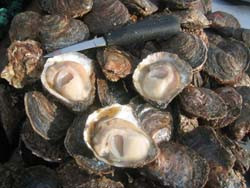Rebuilding Europe's oyster industry
The flat oyster, Ostrea edulis, is an European native and historically part of human diets. Following over-exploitation in the early 20th century, the population crashed but never recovered because of a subsequent parasitic infection and failure of several attempts to fight against it. Production remains low, economically impacting the European oyster industry. The industry's priority is to breed a disease-resistant strain of oysters and thus rebuild the population. The EU-funded OYSTERECOVER(opens in new window) (Establishing the scientific bases and technical procedures and standards to recover the European flat oyster production through strategies to tackle the main constraint, bonamiosis) project aimed to provide the scientific foundation for that priority. The study concerned the life cycle and ecology of Bonamia ostreae and the identification of phenotypic and genetic markers of oyster resistance pacing the development of sustainable genetic breeding programmes. The 15-member consortium ran for 42 months to October 2013. Research initially contributed several new methods for diagnosing Bonamia infection. Subsequently verified by three laboratories, the project's microscopy and molecular techniques were recommended for general use according to set protocols. OYSTERECOVER studied the parasite's life cycle. Foci included initial progression of B. ostreae infection, transmission methods and potential alternative hosts. Such work yielded three management recommendations. Firstly, extreme caution should be employed regarding potential contamination from infected to non-infected areas. Secondly, seawater pumped into hatcheries should be filtered. Finally, appropriate early detection methods should be used on new consignments to detect latent infections. Analysis of the transcriptome of the oyster haemocytes (cells responsible for neutralising bonamiosis) combined with oyster population genetic analysis led to identify two candidate genes as resistance markers. Team members developed a geographic information system tool supporting effective management of cultured and natural oyster beds. Oyster population genetic analysis through the European Atlantic coast revealed three main genetically different groups; this genetic variability must be taken into account when implementing oyster restoration and selective breeding programmes. The group further investigated efficient usage of spat collectors, yielding additional recommendations for the industry. The project's main achievement was identification of genetic and phenotypic markers of resistance to bonamiosis. OYSTERECOVER determined several biological factors affecting parasitic infection of commercial oyster populations. Such work was a first step towards breeding programmes that may yield disease-resistant varieties in the future.







